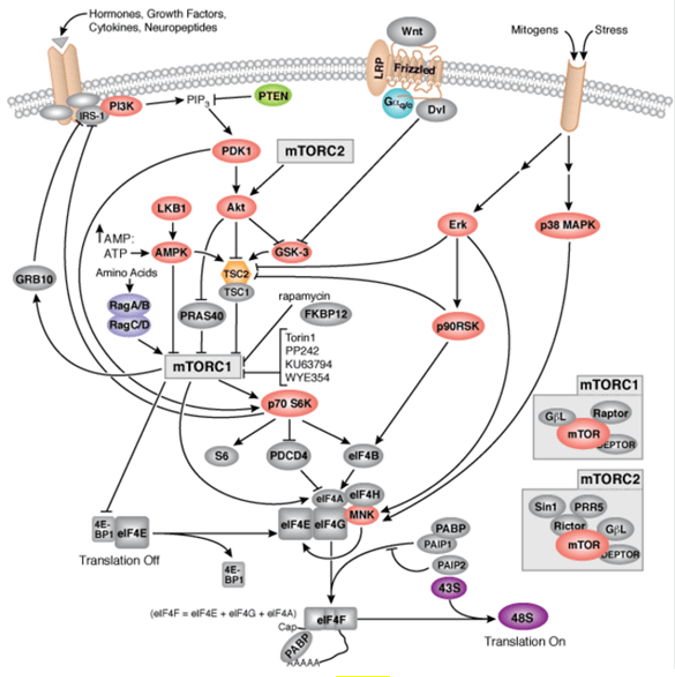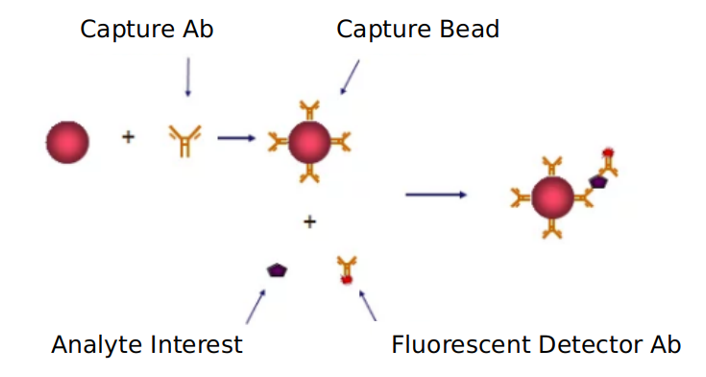S6 kinase signaling pathway
Based on Luminex technology platform, Creative Proteomics provides analysis services for key targets of S6 Kinase signaling pathwaw
 (Thakur A, et al., 2018)Ribosomal S6 kinase belongs to the threonine/serine kinase family, including the P90RSK and P70S6K protein families, and is named for its ability to mediate ribosomal S6 protein phosphorylation, which can play a role in a variety of cellular physiological and pathological processes by phosphorylating intracellular proteins, and is also closely related to the development of cancer.
(Thakur A, et al., 2018)Ribosomal S6 kinase belongs to the threonine/serine kinase family, including the P90RSK and P70S6K protein families, and is named for its ability to mediate ribosomal S6 protein phosphorylation, which can play a role in a variety of cellular physiological and pathological processes by phosphorylating intracellular proteins, and is also closely related to the development of cancer.
S6 kinase is an important member of the cell signaling pathway. A 90 kD protein kinase was first identified in African clawed toad eggs, which phosphorylates the 4OS ribosomal subunit S6 protein, thereby promoting the translation of certain mRNAs and playing an important role in the regulation of cell growth and proliferation. So far, four RSK isoforms have been identified and they are widely expressed in higher eukaryotic cells. With progressive research, RSK has been found to play important roles in a variety of life activities, including participation in cell cycle regulation, regulation of gene transcription, regulation of cell survival and apoptosis, promotion of cell proliferation and differentiation, and participation in the formation of learning and memory.
S6 kinase is a substrate of ex tracellular signal-regulated kinases (ERK) and belongs to the threonine/serine kinase family. It also acts as an important primary effector downstream of the Raf-M EK-ERK cascade signaling pathway, regulating not only cell cycle, gene transcription and maintenance of cell survival, but also cell division, survival and differentiation by phosphorylating intracellular proteins in a variety of cellular pathological and physiological processes. As a tyrosine kinase, the Wee1 signaling pathway is widely used in lung cancer, colorectal cancer, prostate cancer, acute myeloid leukemia, breast cancer in clinical trials, head and neck cancer.
Our detectable targets:
| Fas | ISRE | mTOR | PKR | RIG-1 | TRAF3 |
| GAS | IRF9 | MEKK1 | p38 | RIP1 | TRAF5 |
| MHC-II | IRS1 | MEK6 | p50 | SLP76 | TRAM |
| RTK | PI3K | TYK2 | STAT1 | STAT2 | STAT3 |
| TNFR | ISGF3 | MSK2 | PI3K | TBK1 | Vav |
| PSGL1 | IRS2 | MSK1 | TLR3 | Tak1 | TRIF |
| CD3 | IRF5 | MEK3 | p38MAPK | SH2 | TRAF6 |
| TCR | icam1 | Mda-5 | NFκB |
Technology platform:
We provide Luminex technology for S6 Kinase signaling pathway analysis.
Luminex technology is a multifunctional liquid phase analysis platform developed on the basis of colored microspheres, laser technology, applied fluidics and high-speed digital signal processing technology. The core is to encode polypropylene microspheres or magnetic microspheres with fluorescent dyes. By adjusting the different ratios of the two fluorescent dyes, up to 100 microspheres with different fluorescence spectra can be obtained. Antigen-antibody, enzyme-substrate, ligand-receptor binding reactions and nucleic acid hybridization reactions are performed on microspheres with different fluorescence encoding. Qualitative and quantitative analysis by laser detection of microsphere coding and reporter fluorescence separately.
In addition to Luminex multiplex assay, enzyme-linked immunosorbent assay (ELISA), flow cytometry (FACS analysis) technology can also be provided to meet other customer needs.
Advantages of S6 kinase signaling pathway detection:
- High-throughput: Simultaneous analysis of multiple target molecules in the same sample. Theoretically, the detection flux is equal to the number of types of microspheres, that is, up to 100 types.
- Low sample consumption: Because 100 different target molecules can be detected in the same reaction well at the same time, the amount of sample is greatly saved; and because of the small size of the microspheres, as little as 1 puL of samples can be detected.
- Simple and fast operation: Because it is a liquid phase system, the reaction time is greatly shortened, and multiple cytokine detection can be completed within 2 to 3 hours.

Application of our service:
- Study the regulatory mechanism of S6 kinase signaling pathway in clinical diseases
- Research on the effects of various medical viruses on the S6 kinase signaling pathway
- Study the effect of carcinogenic drugs or therapies on the S6 kinase 1 signaling pathway
Creative Proteomics has developed a signal pathway target detection platform. We are not limited to providing S6 kinase signal path detection services, but can also provide other signal path detection services. If you want to detect other targets, please contact us and we will customize the service for you. Look forward to working with you.
References:
- Thakur A, Sun Y, et al. Anti-invasive and antimetastatic activities of ribosomal protein S6 kinase 4 in breast cancer cells. Clinical cancer research, 2018,14(14).
- Fujita N, Tsuruo T, et al. Phosphorylation of p27Kip1 at threonine 198 by p90 ribosomal protein S6 kinases promotes its binding to 14-3-3 and cytoplasmic localization. The Journal of Biological Chemistry, 2019, 278(49).
- Lehoux S, Cavet ME, et al. 14-3-3beta is a p90 ribosomal S6 kinase (RSK) isoform 1-binding protein that negatively regulates RSK kinase activity. The Journal of Biological Chemistry, 2019, 278(20).



